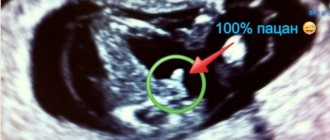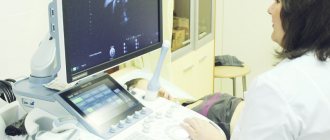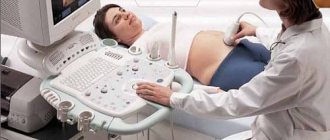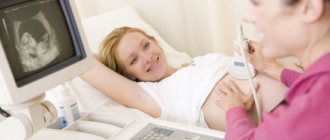Pain
Mild painful sensations that occur here and there are a common occurrence in the last months of pregnancy. Do not forget that the mother’s body experiences enormous stress during the period of bearing a child. Most often the pain is localized:
- in the lower abdomen and hypochondrium:
- in the calf muscles;
- in the head and neck;
- in the lower back.
If in the early stages pain in the lower abdomen appears due to the threat of miscarriage, then at week 29 they are caused by other reasons. These include rapid stretching of the muscular ligaments of the uterus, a shift in the pregnant woman’s center of gravity, pressure changes, and a lack of vitamins and microelements. The expectant mother should listen to her feelings and not delay going to the doctor if the discomfort worsens.
Discharge
Watery or bloody discharge is more dangerous. If they are detected, it is best to call a doctor at home, and if the condition allows, go to the clinic yourself. If the doctor confirms the threat of premature birth, the expectant mother will have to go to the hospital. Doctors always try to maintain the pregnancy, but if this is not possible, they perform a caesarean section.
Discharge from the genital tract is considered normal if it is not abundant, odorless and light in color.
If yellowish discharge appears, you should consult a gynecologist. It may be thrush, which can be treated with medication.
Enlarged uterus
The height of the uterine fundus is 29 cm (this figure is always equal to the number of weeks of pregnancy). The main female organ in which the embryo develops is already so large that sometimes it becomes difficult for a woman to take a breath. The uterus puts pressure on the diaphragm and causes shortness of breath. It seems that she has nowhere else to grow, but there are still three whole months ahead. During this time, it will become even larger, causing discomfort:
- frequent urge to urinate;
- indigestion, heartburn, constipation, hemorrhoids;
- weakness and dizziness, especially after resting in a supine position;
- swelling and varicose veins.
Severe swelling can trigger the onset of late toxicosis, when it is difficult to remove fluid from the body and the pregnant woman constantly feels sick. With this disease, the child receives insufficient oxygen, which can lead to developmental delays. Training contractions will become constant companions of pregnancy. Periodic uterine contractions can occur at any time of the day. It is necessary to carefully monitor the speed and intensity of muscle tension. If the sensations intensify, you should immediately go to a medical facility.
Fever and colds
It is difficult to protect yourself from colds during epidemics. Therefore, the expectant mother needs to arm herself with information on how to deal with the disease without harming herself and the baby. Here are some useful tips:
- Measure your body temperature. It must be remembered that in pregnant women it is slightly elevated - about 37 degrees. Therefore, when you see this figure on the thermometer, you should not panic - there is no fever.
- Take medications only as prescribed by your doctor. During pregnancy, almost all medications are prohibited. The general practitioner knows best which medications will not harm the child, so you need to buy medications with a prescription.
- Rest and sleep more, ventilate the room.
- Drink more warm liquids: tea, water, fruit drink, milk.
- Use traditional methods of treating colds. Herbal medicine will help cope with runny nose, cough and headache.
Baby
At the 29th week of pregnancy, the baby continues to accumulate fat under the skin, folds and wrinkles are smoothed out, and, as a result, the skin becomes smoother. The body is still completely covered with vellus hair, the number of which at this stage decreases sharply. But hair growth on the head is activated. They become denser, darker and grow quickly. In the womb, the baby blinks frequently, moves less actively, and movements become less intense and frequent, but smoother. There is less and less space left in the uterus, so the child is most often in the same position, straightens his limbs, exposes his head and pelvic end. His height by this week is 36-37 cm, and his weight is 1,200-1,300 g. At this stage, the child is in a cephalic presentation, since his head is heavier than his buttocks. But there are often cases when in the water space at 29 weeks the baby is still in a breech position. The expectant mother should not worry about this, because there are still a few weeks for the baby to take the correct position. Otherwise, breech presentation will become one of the compelling reasons for choosing a method of delivery.
Possible problems
- Nausea at 29 weeks of pregnancy in combination with edema and high blood pressure may indicate the presence of gestosis, which is otherwise called late toxicosis. This is a condition that requires careful monitoring of the pregnant woman’s condition, as well as adjustments with the help of nutritional recommendations and medications.
- Varicose veins and hemorrhoids are diseases that develop due to the increasing load on a woman’s body. You need to try to prevent their occurrence, so that you don’t have to suffer later trying to get rid of them.
- High weight gain is the result of poor nutrition or a sign of edema. In any case, weight must be kept under control and the reasons for its excessive increase must be understood.
- A cold is a disease that a woman may encounter during pregnancy. To avoid this, you should try not to visit crowded places where the risk of infection is much higher. And if the disease has not spared you, stay home, drink more and rest. Unfortunately, many medications that we are used to treating are prohibited during pregnancy, so in any case, consult your doctor.
- A change in the nature of the discharge, which normally should be colorless, homogeneous and odorless, indicates risks to the health of the expectant mother and her baby. Therefore, you should not delay your visit to the gynecologist. And if the discharge is bloody or the changes are accompanied by increasing pain, call an ambulance.
- Increasing fatigue is normal for a woman who is already approaching her due date. The body wears out because it works for two. This is felt both in the heaviness in the legs and in the tachycardia caused by the increased load on the heart. The main thing is to get enough rest and not exhaust yourself.
- Pregnancy is also accompanied by all the symptoms associated with increased pressure from the growing uterus on nearby organs . These include frequent urination, constipation and heartburn. The uterus can also put pressure on the inferior vena cava when a woman sits with her legs crossed or lies on her back. Because of this, the pregnant woman may feel dizzy and experience tinnitus. In this case, it is advisable to immediately change your position.
Future mom
Women at 29 weeks of pregnancy still experience discomfort as the uterus continues to grow rapidly. This is especially felt by the organs that are located next to it - the bladder, stomach, and also the lower part of the large intestine. As the uterus grows, they shift and occupy a rather uncomfortable position, which can affect their work in the future. That is why at this time women often complain of a feeling of heaviness after eating and suffer from heartburn. Heartburn occurs as a consequence of stomach contents refluxing into the esophagus and is manifested by an unpleasant taste in the mouth, as well as a burning sensation inside. During pregnancy, the muscles that separate the esophagus from the stomach are heavily influenced by hormones and relax. This creates a similar situation. The rearranged position of the stomach only worsens the current situation. It is impossible to completely get rid of this condition. Of course, after giving birth this problem will solve itself, but in order to somehow help herself, a woman should eat often, but in small portions. It is important to chew your food thoroughly. These simple rules will help reduce the risk of heartburn after eating.
In addition, at week 29, expectant mothers notice increased urination, which in most cases will accompany them until childbirth. Frequent urge occurs due to rapidly progressive pressure on the bladder. False urges are also common during this period. These are situations when the bladder is not yet full, but the brain has already sent a signal about the need to urinate. In such cases, urination does not occur at all or occurs in a minimal amount. During pregnancy, frequent and completely painless urination is not a sign of any disease. However, if this process is accompanied by symptoms such as pain, the appearance of cloudy urine, you should immediately report this to your doctor, who will be able to determine the cause of these changes and exclude or confirm pyelonephritis.
Water
The composition, purity and quantity of amniotic fluid is of considerable importance. It protects the baby from adverse environmental influences throughout pregnancy.
Amniotic fluid changes during pregnancy. By the end of the 29th week, the amniotic fluid contains fetal urine. It also contains oxygen, carbon dioxide, vitamins, secretions of the fetal sebaceous glands, droplets of fat, etc. Every day, the child excretes about 500 ml of urine into the amniotic fluid.
The normal amniotic fluid index at 29 weeks is 84–254 mm. The amount of amniotic fluid is determined to monitor the state of fetal development. Deviations from the norm in the amniotic fluid index allow the doctor to diagnose polyhydramnios or oligohydramnios, and take the necessary measures accordingly.
The amount of amniotic fluid allows you to exclude or confirm postmaturity, abruption, congenital developmental anomalies, intrauterine fetal death, and placental pathologies.
Baby
Week 30 is characterized by intensive growth in the baby’s muscle mass. He actively trains the muscles of the limbs, makes frequent movements, because during childbirth, all muscle groups of the arms, legs, chest, and back must be prepared. In the second stage of labor or during the immediate birth of a child, active contraction of the uterus and abdominal wall muscles occurs. The child makes movements independently. In this he is helped by the high tone of the body muscles, which significantly facilitates movement along the birth canal, and also allows for forward movements. Also this week, the preparation of the internal organs of the fetus for extrauterine life continues. The baby's chest is actively training, expanding and contracting. Such movements are very similar to breathing. The lungs are washed with amniotic fluid, and intensive production of surfactant continues. This substance ensures normal pulmonary respiration. The development of the alveoli can also be noted. These bubbles of lung tissue are necessary for gas exchange, because it is very important for the survival of the fetus to be ready for independent breathing during birth. It is worth noting that childbirth at the thirtieth week, which is due to any reasons, gives a high chance of independent breathing of the newborn, because the lung tissue is already mature and is quite ready to perform its functions.
The fetus actively swallows amniotic fluid, thereby contracting the gastrointestinal tract and stimulating the functioning of the liver and pancreas. The liver in the body of any person performs an important function, purifying the blood, and already at this stage of pregnancy is ready for full functioning. The formation of liver lobules is almost complete by the thirtieth week. Amniotic fluid constantly flows and stimulates the kidneys to intensively function: producing urine from the liquid part of the water. The daily rate of urine at this stage in a child can reach 0.5 liters.
Active work is also observed in the pancreas, which produces hormones and enzymes from the amniotic fluid. One of the most important is insulin. Potentially, already at this stage the pancreas is ready for full-fledged work and will be able to supply the newborn’s body with everything necessary.
Thus, at the thirtieth week, the internal organs of the fetus will be able to ensure its vital functions in the event of childbirth. Although their development actively continues until childbirth. The baby's height is 37-38 cm, and his body weight is about 1,300-1,400 g.
Baby on ultrasound
During the entire pregnancy, a woman should undergo three routine ultrasounds. Week 29 is not included in the periods when the procedure is mandatory. Ultrasound examination at this time is carried out for two reasons:
- referral to a gynecologist observing the woman if complications are suspected;
- the expectant mother’s own desire (in a private clinic for a fee).
The second option is often used by women who want to capture their baby in a photo or video. At this time, you can clearly see the child on an ultrasound in three-dimensional or four-dimensional format.
Every woman worries whether the size of the fetus is normal. At 29 weeks, the fetometric indicators given in the table are optimal.
| Index | Dimensions |
| BPR (biparietal head size) | 71-82 mm |
| LZR (fronto-occipital head size) | 86-102 mm |
| DBL (femur length) | 52-60 mm |
| DKG (length of the tibia bones or length of the tibia) | 47-55 mm |
| DKP (shoulder bone length) | 47-55 mm |
| Head circumference | 255-295 mm |
| Abdominal circumference | 228-278 mm |
In addition to the main dimensions, the child’s weight, presentation, degree of maturity of the placenta, and the number of umbilical vessels are assessed. The doctor should carefully examine the internal organs for pathology. During this period, deviations are clearly visible due to excellent visualization.
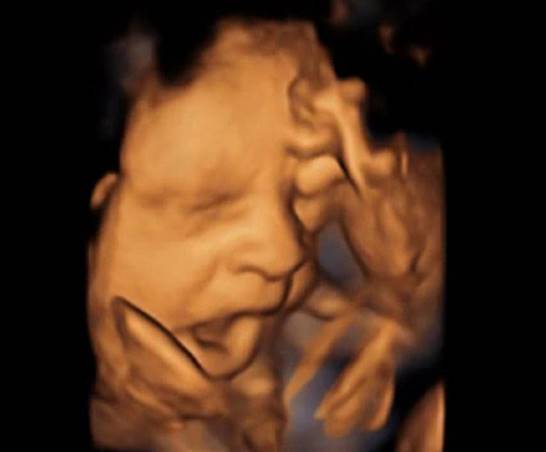
On three-dimensional and four-dimensional ultrasound you can see how the child yawns and smiles
Future mom
At the thirtieth week, the expectant mother may experience active breast swelling, as well as the release of colostrum. This secretion of the mammary gland – “primary milk” – is quite thick and has a white or yellowish tint. The release of colostrum can occur at different times, everything is very individual, but most often it happens after the 30th week of pregnancy. If you find such discharge in yourself, this means that your body is actively preparing for the upcoming lactation. In the first few days after the birth of a child, colostrum from the woman’s body will be released very actively until breast milk appears.
During pregnancy, the fetus itself stimulates the production of colostrum. His adrenal glands produce a special hormone that, when interacting with placental hormones, activates the production of prolactin. Prolactin is a hormone from the mother's pituitary gland, which is responsible for milk production after childbirth.
At the 30th week of pregnancy, a woman receives a certificate of temporary incapacity for work, and also undergoes the procedure for registration of maternity leave, the duration of which is only 140 days.
How many months is this
The eighth obstetric month begins at 28–29 weeks of pregnancy. At this point, the woman has been carrying the child for exactly 7 months and several days.
The period is counted not from the moment of fertilization of the egg, but from the first day of the last menstruation. Therefore, in fact, a woman carries a fetus for 6 calendar months and 3 weeks.
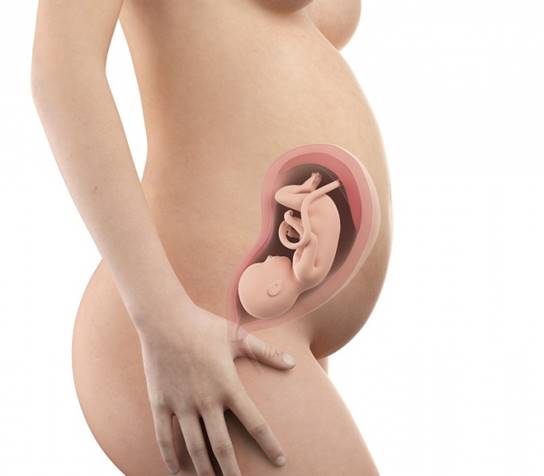
Week 29 is 7 months and a few days
There are about 11 weeks left until the expected birth. This period is considered conditional. After all, a small number of pregnant women give birth on the date set by the doctor. In 95% of cases, birth occurs before or after PDR.
Baby
At 31 weeks of intrauterine life, the fetus weighs 1,500-1,600 g and has a height of 39-40 cm. This period is characterized by the continued development of the nervous system. The brain grows with high intensity, the convolutions deepen, and the surface area of the cortex increases. The brain, as well as its parts, thanks to nerve connections, function as one whole. The baby's periods of sleep and activity are already clearly alternating. Sleep, as before, takes up most of my time. It is worth noting that a child closes his eyes during sleep, and opens them during activity. The eyelids are so well developed that at this stage the fetus can already blink, open and close its eyes, squint and even squint. Exposure to bright light on the stomach causes the baby to close his eyes, which indicates a good level of development of his nervous system.
Future mom
By this time, the weight of the expectant mother increases by 7-8 kg. For pregnant women, it is important to monitor the rate of weight gain, because too much weight gain may indicate poor kidney function. So, per week the weight should increase by no more than 300-400 g. In addition, it is important to monitor the presence of swelling in the extremities and, if they are detected, notify the doctor. Fluid retention is a sign of pregnancy complications. Preeclampsia, which is also called late toxicosis, is characterized not only by swelling, but also by increased blood pressure, as well as the appearance of protein in the urine.
In the initial stages, gestosis can be completely asymptomatic, so a pregnant woman may not notice any changes at all and feel great. That is why it is important to constantly visit a doctor who can, based on tests, determine the presence of late toxicosis. Preeclampsia is one of the main causes of complications in both the mother and her child. It can provoke delayed fetal development, hypoxia, and negatively affect the functioning of the kidneys, vascular system and heart, as well as the woman’s liver.
Mild gestosis manifests itself in the form of edema. It can be corrected by normalizing water-salt metabolism. The doctor may prescribe special diets for the pregnant woman, as well as medications that will help cope with this condition.
Moderate or severe gestosis (nephropathy, preeclampsia and eclampsia) requires urgent hospitalization. Intensive therapy is provided in a hospital setting. Nephropathy in the expectant mother manifests itself not only in the form of edema, but also high blood pressure, as well as the appearance of protein in the urine, which is detected during tests.
Active progression of gestosis can cause severe nephropathy, which gradually develops into preeclampsia. This condition is manifested not only by edema, high blood pressure, protein in the urine, but also by circulatory disorders in the brain. Women report frequent dizziness, pain, as well as nausea, vomiting, and changes in reflexes.
Preeclampsia at its most severe stage (eclampsia) is characterized by the manifestation of convulsive seizures, which can cause coma. That is why it is important for a pregnant woman to detect signs of gestosis in the early stages in order to avoid an increase in symptoms, which in the future can lead to irreversible consequences.
Analyzes and examinations
Before going on maternity leave, a woman will need to undergo a number of tests:
- OAM (general urinalysis);
- CBC (complete blood count);
- blood chemistry;
- blood for hepatitis B, C, HIV, syphilis;
- cytological analysis of a vaginal smear.
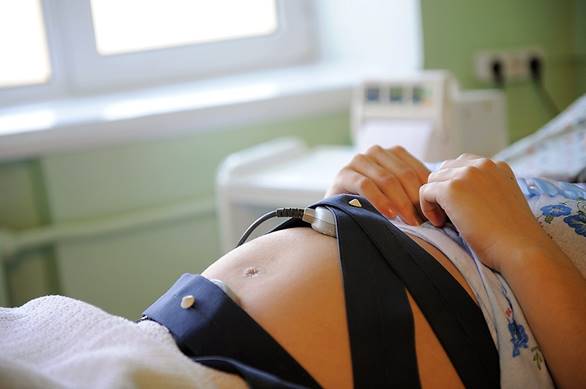
If a woman has a negative Rh factor, she will need to donate blood to determine antibody titers.
Some pregnant women are prescribed CTG (cardiotocography). It is carried out according to indications when an unfavorable condition of the fetus is suspected.
Baby
This week of pregnancy is an important stage in the development of the fetus’s immunity, in the blood of which there is a sharp increase in its own immunoglobulins. These substances protect the child from infection. At the time of birth, the level of immunoglobulins will increase greatly due to the penetration of mother’s immunoglobulins into the child’s body. The last weeks of pregnancy are characterized by excellent permeability of the placental barrier, so protective cells from the mother’s body easily pass into the baby’s blood.
At this week of pregnancy, the child weighs about 1,700-1,800 g, and his body length is 41-42 cm. It is also worth noting that his facial features are approaching the appearance of a newborn, his face is rounded, wrinkles are smoothed out, and the hair on his head is actively growing. The even distribution of fat under the skin allows the baby to change skin color from bright red to pink.
The accumulation of subcutaneous fat is very important for thermogenesis. This process is necessary to constantly maintain body temperature at the same level. In an adult, these processes are controlled by special thermoregulation centers in the brain. At the time of birth, the child is not yet able to fully ensure thermoregulation, which is why the presence of subcutaneous fat is so important for him to maintain the required body temperature.
Difficulties in pregnancy
It is becoming increasingly difficult for a woman to bear a child. Therefore, the likelihood of injury from falls is high.
In addition, there are other risks during pregnancy:
- the onset of premature birth;
- delayed fetal development;
- FPN;
- gestosis and other pathological conditions, exacerbation of chronic diseases.
Isthmic-cervical insufficiency
Isthmic-cervical insufficiency is a condition in which there is shortening or premature dilatation of the cervix. If any abnormalities are detected, the woman is placed in the pregnancy pathology department.
An installed obstetric pessary helps to cope with the problem. In particularly critical situations, surgical sutures may be applied.
Insufficiency of placental blood flow
Fetoplacental insufficiency is a dysfunction of the placenta under the influence of various factors. There are several degrees of FPN, characterized by different symptoms and intensity of disorders in the body of the mother and fetus.

If bloody discharge appears, you should urgently call an ambulance
The most dangerous consequence of FPN is circulatory disorders and the development of hypoxia, which can lead to intrauterine fetal death. Sometimes it is necessary to deliver prematurely to preserve the viability of the baby.
Placental abruption
One of the most dangerous complications is placental abruption. It is often triggered by a blow to the stomach or a fall. But sometimes it can develop as a result of exacerbation of a chronic disease.
Bloody discharge and spasms of the uterine walls with severe pain can signal a violation. If such symptoms are detected, you must immediately call an ambulance.
Intrauterine infection of the fetus
Intrauterine infection of the fetus can occur during pregnancy. This complication is the most dangerous and most often leads to neonatal mortality.
Among the most common diseases are:
- rubella;
- cytomegalovirus;
- herpes simplex virus;
- viral hepatitis;
- flu;
- HIV infection.
To determine the presence of infection, a woman needs to undergo tests.
Future mom
The third trimester of pregnancy can be manifested by pain in the back, pubic area, as well as knee and hip joints. There may also be a feeling of bursting of the pelvic bones and pain. Such phenomena are present in many pregnant women, since the center of gravity changes and the spine shifts (due to the growth of the abdomen). At week 32, the woman’s body is already actively preparing, producing the placental hormone - relaxin, which is responsible for relaxing the ligaments, making the pelvis pliable during childbirth and thereby ensuring the easiest and most comfortable movement of the baby through the birth canal. Too much of this hormone causes pain and loosening of the ligaments. That is why pregnant women are recommended to undergo regular physical activity in the form of walking, yoga, fitness, and swimming. Strong muscles will be able to support the spine, and will also reduce discomfort in the lumbar region and pain. Doctors recommend that women wear a brace and sleep on their side to avoid significant stress on their back. Also, special devices (pillows, bolsters) will not be superfluous, which will allow the expectant mother to fully rest at night, take a comfortable position that will help relax the muscles of the back and legs.
Woman's feelings
Every week a woman begins to feel a greater need for rest. This is due to the growth of the abdomen and the possible appearance of pain. A pregnant woman can hardly walk, drive a car for a long time, or sit still.
Due to the size of the abdomen, it is already difficult to see the legs in a vertical position. Therefore, a woman should be careful when moving.
All these changes affect the physical and emotional state of the expectant mother. A joyful event is that the 29th week is the last for working mothers. From the 30th week, official sick leave begins, which many call maternity leave.
Baby's movements
Almost all pregnant women at 29 weeks feel a change in the nature of the baby’s movements. This is due to the fact that there is little room for him to turn over and swim inside the uterus.
From this period, the movements resemble dancing. The turns become smoother, the child can rest his legs or arms against various parts of the uterus, in the area under the ribs. Thin women may see the heel or fist stand out through the fat layer on the abdomen.
From 29 to 32 weeks, the baby’s peak activity is observed. Despite the fact that the “kicks” become less frequent, they are more noticeable and sometimes painful. The change in the nature of movements is due to the development of the nervous system. The baby begins to control his movements.
Important! Women begin to allocate periods of wakefulness and sleep for the child. From this period, movements per day are counted. The pregnant woman should report the results to the doctor.
How to count movements
By the number of movements one can judge the condition of the fetus. Despite the fact that doctors now do not often focus on these indicators, it is necessary to count the number of pushes and kicks per day. Such techniques partially replace the CTG procedure.

To monitor the child’s condition, it is necessary to count daily movements
To record your calculations, you need to keep a diary. The time and number of movements must be recorded daily. There are several main methods of counting.
- The most popular is the Pearson method. Many women know it as “Count to Ten.” Every tenth movement from 8 am to 8 pm is entered into the table. The normal indicator is 10 movements of the child within half an hour.
- The second convenient method is the Cardiff method. Its essence is to record 10 movements of the child over 12 hours.
- Sadowski's method involves assessing activity within an hour after the mother eats food. If a woman counts 4 or more movements, the baby is fine.
It is important to register the correct movements - single or group movements, pushes, revolutions. Hiccups should not be taken as an indicator.
If activity is reduced, then severe fetal hypoxia is suspected. In case of increased activity, symptoms of early hypoxia can be diagnosed. To clarify the child’s condition, CTG and ultrasound with Dopplerometry are performed.
Pain
A woman may experience pain. The most common are discomfort in the back and lower back. The pain is associated with the growth of the uterus and the fact that the ligaments that support it cannot cope with the overload.
The back muscles become more tense due to a shift in the center of gravity. The back feels the load, holding the large chest and stomach.

Sharp nagging pain in the lower abdomen requires emergency help. They may indicate preterm labor has begun.
Pain in the legs can also be pronounced, especially with prolonged walking or standing. At night, cramps appear in the calf muscles.
If your blood pressure rises, headaches may occur. They are associated with increased stress on the heart and blood vessels.
During this period, the woman’s body begins to prepare for childbirth. Therefore, a pregnant woman may feel pain in the pubic bone area. The sensations are due to the fact that the pelvic bones and ligaments soften and expand. This is necessary so that the baby's head passes through the pelvis. But excessively strong ones can be a sign of symphysitis. To clarify the condition, you must consult a doctor.
Discharge
At this time, women notice an increase in the amount of discharge and a change in its consistency to a more liquid one. This is due to increased production of the hormone estrogen in the body. Due to the secretions, the genital tract remains clean and healthy, and is prepared for labor.
The following discharges are considered normal:
- slightly liquid consistency;
- light white or slightly yellowish tint;
- odorless or with a faint sour milk odor.
If there is a deviation from the norm (purulent, bloody, thick white), you must consult a doctor and get tested to detect infection.
Bloody discharge is especially alarming. They signal problems with the placenta and the onset of premature labor.

